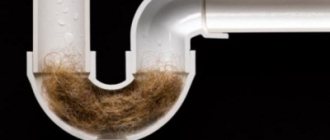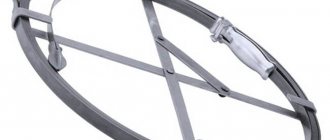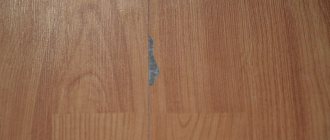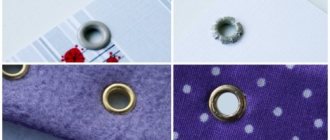In most cases, you can correct the situation on your own, using mechanical cleaning methods, special chemicals and even folk recipes.
In this article you will learn how to quickly and effectively clear a clogged kitchen sink at home.
Reasons for appearance
Before cleaning the drain, it is recommended to determine the cause of the blockage. The main ones include the following:
- Incorrect installation of plumbing. This could be, for example, installing waste pipes at the wrong angle.
- Foreign objects entering the drain that block and clog the pipe.
- Gradual accumulation of fat and other deposits in the pipes.
In cases where improper installation occurs, simply cleaning the pipes is not enough.
How to unclog hair in the sink
By far the biggest culprit of a clogged sink is hair getting into the drain. Of course, if you see how your own hair or the hair of your pet (cat or dog) is clogging the hole for the plug, then a clothes hanger or some other tool will help to physically remove it.
However, if you don't see it, it means there is a clog somewhere below, which in turn requires the use of a sink unblocking product such as Mr Muscle, which chemically dissolves the hair. It's not the most environmentally friendly option, but sometimes it's the only solution that will work.
Unscrew the U-bend and clean the pipe by hand
This is the most time-consuming option, but it may be the only way to unclog your sink that will actually work. Prepare a bucket and place old towels on the floor.
It is also recommended to open the window, as the U-bend can get a little suffocating.
Clean the drain thoroughly using a rag and a bottle brush or an old toothbrush to really get rid of stubborn items that have accumulated in the drain. Reconnect the U-bend, making sure the seals are tight.
How to clean mechanically?
Mechanical cleaning methods are often used to remove blockages . These include the use of a glass, a plunger or a special cable.
Plumbing cable
The cleaning cable is often metal. It has a handle on one side and a split, hard end for cleaning on the other.
Application:
- The working part is lowered into the drain.
- By turning the handle, the cable is moved along the drain pipe.
- After removing the cable from the drain, there may be debris at the end of the cable that is obstructing the passage of water.
- Repeat the procedure several times.
- Check the quality of cleaning by pouring water into the sink.
- If necessary, I repeat the processing.
Mechanical cleaning can be supplemented by using special chemicals or home recipes.
You can watch how to work with the cable in the following video:
Cup
For small blockages, when water passes through, but not as quickly as usual, even an ordinary glass can help.
Principle of operation:
- take some water into the sink;
- lower the glass so that it covers the drain hole;
- press and then sharply move your hand with the glass up;
- repeat several times.
Cleaning using this method is similar to the principle of using a plunger, but it will not help deal with serious blockages.
plunger
It is advisable to have a plunger in the household - a simple tool that will help deal with fresh blockages.
Procedure:
- fill the sink with some water;
- install the plunger so that the drain is completely covered with the working nozzle;
- press the plunger with force and pull it sharply towards you;
- repeat the treatment several times in a row, even if the plug has already been removed.
In addition to the usual plunger, you can use pneumatic models.
Why does the sink clog?
Before you begin to remove the blockage, you need to understand the structure of the siphon. Usually, after cleaning it, it is possible to eliminate the obstruction of waste water through the drain. As a rule, bottle siphons are installed, which are made with a diameter of 32 or 40 millimeters. Practice shows that siphons with a 32 mm diameter clog faster. All siphons used in residential buildings and apartments can be divided into several types:
- bottled - such products have a removable part that looks like the bottom of a bottle. To unscrew it, no special tools are needed. Clearing a blockage in such a siphon is not difficult;
- pipe - these products are curved tubes;
- corrugated - these siphons can be bent in different ways, so they are installed in the most unusual places. They are especially often installed in apartments with a small area;
- hidden - they are placed in a box;
- with overflow - this siphon requires a special sink that has a hole to drain excess water;
- with a double or tee - such products are in great demand because they are intended for connecting several household appliances at the same time, for example, a washing machine and dishwasher;
- flat - they are installed when they are going to place a large-sized device under the sink, which could be, for example, a mini washing machine. And although these siphons are rarely installed, they are convenient because they take up little space.
Causes of blockages
Cooking is accompanied by the formation of a wide variety of garbage. Mostly these are leftover food items or prepared meals. Small debris and liquid waste usually end up in the sink. They are the cause of blockages.
- Leftover food – skins, peelings, bones, eggshells, leftover fibrous food. All this, in places of turns and narrowings, easily forms a general structure and fills the pipe.
- Residues of tea and coffee - tea leaves and pieces of grain - settle on the walls of the pipes, forming a dense layer. Plaque increases slowly, but successfully reduces the working diameter. At the same time, the water leaving the sink becomes worse and worse.
- Porridge and raw cereals - especially the latter. Under the influence of water, they swell and get stuck in narrow places, forming reliable plugs.
- Fat and oil - the drain comes in liquid form, but under the influence of cold water the substances solidify, turn into a solid form and are firmly attached to the walls of the pipe. Fatty deposits trap small debris, then larger ones, until you end up with a dense, impenetrable plug.
- Bad water can also cause a blockage. If the liquid contains a large amount of salts and rust, they are deposited on the walls of the pipes, forming a durable, dense coating. Such a blockage is difficult to eliminate.
How to remove using folk remedies?
Even simple homemade recipes can help solve the clog problem. But it is better to use them in cases where the blockage is not severe. If the water does not drain from the sink at all, it must be scooped out before cleaning.
Boiling water
This is the simplest and most accessible.
Procedure:
- It is necessary to bring at least 1.5 liters of water to a boil.
- Pour boiling water into the sink, being careful to direct the stream into the drain.
- If the water begins to go away, then after 1.5 hours the procedure must be repeated. Otherwise, you will have to try another drain cleaning option.
This method is suitable for flushing out the blockage only if the pipes are not made of plastic. Otherwise, only water with a temperature of up to 70 degrees can be poured into the sewer. Failure to comply with this requirement may result in damage to the plastic pipeline.
Vinegar and soda against fat deposits
To clear clogs caused by food debris, especially greasy food, the baking soda and vinegar method can be used.
Procedure:
remove all water from the sink;- pour ½ pack of soda into the drain hole;
- pour in ½ cup vinegar;
- plug the drain hole to ensure that the chemical reaction takes place in the pipes and not on the surface of the sink;
- wait until the chemical reaction with the formation of foam is completed;
- pour 1.5 liters of boiling water (hot water) into the sink drain hole;
- Run cold water for 3 minutes to flush out the drain.
You can use cleaning with soda and vinegar as a preventive measure.
Hangover pills
If the blockage is not severe and you don’t have soda on hand, you can use effervescent hangover tablets. Alka-Seltzer will do.
Application is simple:
- In a saucepan, mix 2-3 tablets of the drug with a glass of vinegar.
- Quickly pour the foaming solution into the drain.
- Immediately plug the hole with a rag.
- After 10 minutes, turn on the water under pressure.
Alternative use of tablets:
- Grind and pour 2 tablets into the drain.
- Pour in a glass of vinegar.
- Plug the drain hole in the sink.
- Wait a few minutes for the reaction to pass.
- Run hot water.
Salt and soda
Kitchen drain pipes are susceptible to deposits from grease that gets into the pipes when washing dishes.
Application procedure:
- combine 4 tablespoons of salt with 2 tablespoons of soda in a container;
- pour two glasses of water;
- pour into the drain;
- plug the kitchen sink drain;
- stand for 10 minutes;
- run hot water.
This method cannot deal with old blockages.
Video description
How to remove dirt using a cable is shown in this video:
Cleaning with a hydraulic pump and soda
The hydraulic pump helps remove fresh dirt. Clearing a clogged sink is easy:
- First you need to soften the dirt plug. To do this, use a soda solution.
- Half a pack of soda is poured into the drain hole.
- Pour 1 cup of boiling water on top.
- The mass is left for 10 minutes. The time can be increased if cleaning has not been carried out for a long time.
- The hydraulic pump is filled with hot liquid and placed near the drain.
- Using the pressure of the pump, dirt deposits are pushed through and the pipe is cleared of debris.
If after the cleansing procedure the unpleasant odor has not disappeared, but the water still drains slowly, you can repeat the cleansing a second time. If this is not enough, you should pay attention to other cleaning methods.
Removing dirt using Sanfor
"Sanfor" is presented in the form of a gel product containing destructive and cleansing substances in the composition. The product not only pushes through debris deposits, but also prevents their reappearance.
If the sink is clogged, you need to take the following measures:
- View the instructions for use and take the gel product in the indicated dosage.
- Pour it into the drain hole and leave for 2 hours. During this time, a chemical reaction will occur, during which the pollution will begin to break down.
- Turn on the hot water and leave it for 10 minutes.
"Sanfor" is also used for preventive purposes. It is enough to clean the plumbing once every 2 months.
Removing garbage plugs using Tiret Turbo
Tiret Turbo is a popular means for cleaning plumbing fixtures, which is also used for preventive purposes. How to clean a sink with a chemical:
- Pour 200 ml of the chemical product into a plastic cup. If the contamination is old, you can increase the dose to 250 ml.
- Pour Tiret Turbo into the sink and leave for 1 hour.
- Rinse plumbing fixtures with hot water.
If the problem cannot be resolved at first, you can repeat the procedure. But no more than 2 times. Otherwise, the chemicals in the product may adversely affect the condition of the pipes.
Rinsing plumbing after chemical treatment
Deboucher for plumbing fixtures
This universal product removes both old and new stains. It contains chlorine, potassium and sodium. These substances dissolve debris plugs and protect the pipe surface from damage. The cleansing procedure is as follows:
- Pour 500 ml of product down the drain.
- Leave it for 1 hour.
- Turn on hot water for 10 minutes.
A significant drawback of the product is that it is not very economical to use. You will have to use up almost the entire contents of the tube in one go.
"Bagi Pothan" for removing blockages
Baghi Pothan is a product consisting of caustic soda and is used to clean sanitary ware. This product has a sharp and pungent odor and often leads to allergic reactions. Therefore, it is recommended to use gloves and a protective face mask during the cleaning process. The procedure looks like this:
- A few spoons of the powdered product are poured into the drain. This amount is sufficient to dissolve dense debris accumulations.
- Leave the sink for 1 hour.
- After this, rinse the drain with 1 liter of boiling water.
Bagi Pothan should be used no more than once every 3 months.
How to quickly remove with special chemicals?
Various preparations can be used to clean kitchen drains. They are available in liquid form, in the form of granules in sachet.
The main point when choosing is to make sure that the product is suitable for the existing type of pipes and the expected type of contamination.
Bagi Schumanit
The drug, produced in Israel, is available in granular form . It allows you to completely eliminate the blockage in just 3 minutes, dissolving food residues and fat accumulations. Suitable for all types of pipes. Contains sodium hydroxide.
For the product to work, you need to remove the water from the sink. The contents of the sachet are poured into the drain and ½ cup of hot water is poured in. After 3 minutes, the sink is washed with a large stream of water.
Advantages:
- destruction of bacteria;
- elimination of odors;
- very high efficiency;
- fast action;
- dissolution of organic and inorganic substances.
Minuses:
- high price;
- caustic composition.
The average cost of a package is 150 rubles. The product is also available in gel form. Read reviews here, here and here.
Gel Mr.Muscle
The drug in gel form is an effective remedy that acts in a few minutes. If the plug situation is stubborn, the product may need more time to clear the drain.
Advantages:
- efficiency;
- ease of use;
- elimination of bacteria.
Minuses:
- caustic composition;
- price;
- high consumption of funds;
- for advanced cases it will take several hours.
Price – 300 rubles. You will find reviews here and here.
Tire Turbo
The gel is intended for cleaning pipes at home. The product is suitable for all types of pipes. Contains chlorine. A single treatment of one drain hole requires 250 ml of product.
Advantages:
- efficiency;
- works even when there is water in the sink;
- eliminates bacteria.
Minuses:
- price;
- high consumption.
Cost – up to 400 rubles. Reviews can be found here, here and here.
Special means
There are several types of cleaners available to remove clogs.
Liquid and gel
The most commonly used products are those available in the form of a gel or thick liquid.
"Sanfor"
Sanfor will help remove debris from the sink. This is a thick gel mixture produced specifically for removing blockages and cleaning sewer pipes. The dense structure of Sanfor allows it to penetrate deep into the pipe and get rid of plugs, even if there is water left inside. “Sanfor” is poured into the drain and left in it for an hour and a half. Then it is washed off with boiling water.
"Tiret Turbo"
Tiret Turbo is especially popular among housewives. This is a universal tool that will help clean metal and plastic drain pipes. Tiret Turbo is also used to prevent blockages. 200 milliliters of liquid are poured into the drain along with hot water. The procedure is repeated if there is debris left inside the sink.
Deboucher
An effective remedy that copes with both severe and minor blockages. The liquid contains chlorine, sodium, potassium and other active substances that help remove blockages in pipes. Among the disadvantages of Deboucher is that 500-600 milliliters of liquid are consumed for one-time cleaning of the sink.
Loose powder or granules
When cleaning sinks, you can use granular products or special powders.
"Bagi Pothan"
This powder is made from caustic soda and is used in dissolved form. You must use Baghi Pothan very carefully, as it has an unpleasant and pungent odor.
Experts advise wearing a gauze bandage and rubber gloves on your hands when using the powder. One-time use of the powder is enough to clean the pipe.
"Mole"
The most popular chemical used in everyday life is considered to be “Mole”. It is made from acetic acid, potassium and sodium hydroxide. The advantages of "Mole" include its effectiveness, low cost and ease of use. It is enough to use the “Mole” once to clean the sink for a long time.
See also
How to clean a humidifier from mold and scale, the best folk remedies and rules
Chirton "Clean drains"
A highly effective product produced to remove blockages inside pipes. One bottle is enough for 2-3 uses. Chirton does not work immediately, so it is necessary to flush the pipes only 20 minutes after using the drug.
Instructions for use
When using most cleaning products, perform the following sequence of actions:
- Pouring the composition into the drain. To begin with, the product is poured into the sink. If necessary, mix it with warm water so that the mixture is not thick.
- Cleaning the sink. 10-30 minutes after using the cleaning compounds, the pipe must be washed with water.
Disassembling the siphon
Directly under the kitchen sink there is a siphon - a simple structure that can be disassembled. This method is very effective when the cause of the blockage is in the siphon. After all, the water draining from the sink first enters it.
Procedure:
- Free up space under the sink.
- Place a bucket under the siphon.
- You need to unscrew the plastic nuts holding the siphon. Or you can unscrew only the siphon sump nut. In this case, the entire contents of the sump will flow into the bucket.
- Clean and rinse the removed part.
- You can also disconnect the corrugated pipe leading to the drain and wash it as well.
- Install all elements in their original place.
If partial dismantling of the siphon is not possible, it is removed completely, disconnecting it from the sink and drain pipe, and then washed and cleaned in a separate container.
The procedure for cleaning the siphon can be seen in the video:
Where is the blockage?
Cleaning sewer pipes is greatly facilitated and less dirt comes out if the means and methods for it are chosen in accordance with the expected location of the blockage:
- A fat plug can occur anywhere; most often in the kitchen. If the owners decided to save on a siphon for washing and made a water seal for it by bending the standard drain corrugation in a U-shape, the regular appearance of grease plugs in it is guaranteed. Also - in the deck under the sink outlet, if the pipe slope is less than 2 cm/m or more than 5 cm/m. Also at pipe joints, if the sewerage and sealing are done incorrectly, see below. A plug from kitchen scraps can usually be easily broken through with a plunger or removed with chemicals, see below. To push through a plug caused by other contaminants, you most often have to use a cable, because... In this case, you need to pour so much aggressive chemical into the pipe that it will damage the pipe and/or cause leaks at the joints.
- Hair collects in the bathtub siphon; it must be removed from there when the first signs of blockage appear with the snake cable, see below.
- Lint accumulates from the water seal of the washing machine, or, if there is no separate drain from it, from the bathtub or washbasin sink. A radical way to eliminate lint blockage, as well as to avoid its further consequences, is to place a bucket under the siphon, unscrew the standard cleaning hatch on it and remove the contamination with a snake.
- The fecal blockage is localized in the water seal of the toilet, the drain tee, or the section of the riser nearby below. If the toilet is made of earthenware, and the fan crosspiece and riser are cast iron, you can unclog the toilet without the risk of turning into something like its contents, using modern means of chemical sewer cleaning. Otherwise (any plastic) you will have to use a cable in a plastic sheath with a plastic brush or a homemade gentle cable (see below).
- Small hard objects (coins, brooches, earrings, etc.) can settle anywhere. In this case, it is often possible to break through the blockage and even remove the object using a cable with a regular spiral nozzle. Large objects most often have to be pushed until the bed exits into the riser or cesspool (septic tank) using a cable with an attachment: a smooth sliding knife (in plastic pipes) or a shark tooth knife (in cast iron)
How to remove grease
It is necessary to completely clear the blockage in the sink, completing it with chemicals and washing.
Cleaning the sewer system from grease contaminants begins with the devices furthest from the riser. If there is a double sink in the kitchen, the sink that is furthest from the common drain into the bed is cleaned first; The nearby drain is reliably plugged with a plug or improvised means (rag, etc.). You also need to plug the drain and overflow of the bathtub.
If the washing machine drain is stationary, its hose must be disconnected from the additional siphon pipe, and the pipe must be securely plugged, or the hose must be bent in half and tied tightly (but not squeezing!). In general, the best way to prevent waste from getting into the washing machine when clogged is to equip it with a separate drain through a jib 700-850 mm high and a water seal. It’s even safer, but more troublesome, to drain the washing machine into the bathtub or sink.
During the cleaning process, the first step is to open the siphon hatches, starting from the kitchen, and their contents are released or emptied into a bucket. Next, the hatches are closed and chemicals are applied in the same order, according to the instructions for the product or according to the description for the homemade one. After this, the system is washed with hot (50-60 degrees) water at the rate of a bucket for each meter of pipe length, including drains from appliances.
Features of cleaning plastic pipes
Cleaning plastic pipes requires special care. Despite the strength, the material from which the drainage system is made is susceptible to mechanical damage and exposure to very high temperatures.
The inner surface of the pipes is quite smooth; with proper installation, blockages in such a system occur less frequently than in cast iron drainage systems. This is explained by the fact that plastic is not prone to corrosion and the adhesion of various substances to the surface .
But during operation, food particles that fall into the kitchen drain can be deposited, causing a blockage. The best options for cleaning approaches are the use of a plunger, the use of home and special products.
Call a plumber
In situations where you cannot cope with the blockage on your own, you will have to turn to the help of a plumber.
Also, the intervention of a specialist will be needed when the problem with blockage is related to the drainage system in the apartment or to the riser in the house.
The cost of the service is determined by the complexity of the problem and the necessary cleaning work. If replacement of units or individual parts is required, the customer pays for them separately. On average, in the capital, clearing a clogged sink will cost from 500 rubles.
Prohibitions when cleaning
When starting to clear a clogged kitchen sink, you need to remember a number of prohibitions:
- Do not begin to break the plug while there are dishes in the sink. It and food must be removed in advance.
- You should not get to work without rubber gloves. This is especially important when using purchased chemicals, since such products have an aggressive composition.
- Do not use chemicals that are not intended for this purpose to clean pipes. They can emit toxic fumes and even damage pipes.
- You should not pour all the products that come to hand down the drain at the same time, as this can harm communications.
Prevention measures
To prevent blockages from recurring, preventive measures should be taken into account:
- Periodically you need to rinse the sink by running boiling water or hot water if the pipes are made of plastic;
- It is necessary to insert a special strainer into the kitchen sink drain, which will prevent large fragments of food waste from getting into the drain;
- You should not shake bread crumbs into the sink, wash off tea leaves, or pour out greasy liquid, as all this will stick to the pipes and accumulate in the siphon.
Preventive measures
Prevention measures are not complicated , but thanks to them, problems with water drainage will occur much less frequently:
- It is advisable to install a special sieve in the sink drain holes (both in the kitchen and in the bathroom). It will help prevent large particles and hair from entering the drain.
- You should regularly pour boiling water down the drain (for plastic pipes - just hot water). This will prevent sediment from accumulating on the surface of drainage communications.
- You should not clean food residues, construction mixtures, water after washing shoes, etc. into the sink.
Tips from the professionals
Tips from plumbers will help you better cope with cleaning your kitchen sink:
If clogged pipes are a frequent and regular occurrence in your home, then it makes sense to purchase a plumbing cable. It is inexpensive and will last for many years. Having a comfortable handle at one end is a must.- If the problem with blockages is related to installation errors, it is recommended to correct them, otherwise blockages will occur constantly.
- If the blockage was broken through with a cable, it must then be cleaned of dirt and dried. Store in a dry place, rolled up.
- It is better to clean drains in the kitchen with the window open so that there is an influx of fresh air, since in most cases the smell will be unpleasant.
- The combination of mechanical and chemical methods makes pipe cleaning more effective. For example, use a plunger, and then use special household chemicals.
If you are interested in how to clear a clog in a pipe, sink or toilet, take a look at this section.
Who is to blame and what to do?
Two eternal Russian philosophical questions are quite applicable to our situation. First , check whether there is a special mesh on the sink drain that does not allow food debris, large fractions of vegetable peels, hair and pet hair to freely penetrate into the sewer pipe and form such a delicious plug there, mixing with fat.
If there is no mesh , only you are to blame, how to remove the blockage - urgently go to the hardware store for a miracle mesh.
But there may well be a situation where the fat washed off from the dishes remains on the walls of the sewerage elements and catches the smallest food debris and so on. A clog forms, just not so quickly, not once a week, but once a year , and then one day, not a wonderful day, the water stands in the sink, and the plastic mesh, on which so much hope is placed, drifts on the surface of the water.
What should I do? Let's roll up our sleeves and get down to business.
But the owners are not always to blame; let’s list all the causes of blockages:
- the fine litter already mentioned above (food remains, fat, threads, hair);
- corrosion of pipes (typical of old housing stock);
- defects in the operation of the sewer system (improper installation of the siphon, depressurization of the pipeline, etc.).
In our article we will analyze options for action for the first, most common reason. If old pipes are corroded, they become brittle - in this case, they should be replaced with more modern building materials (in a plastic pipe, for example, there will be no such deposits).
If there are defects in the sewer system, specialists should be invited to diagnose and fix the problem.











